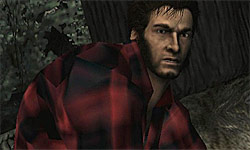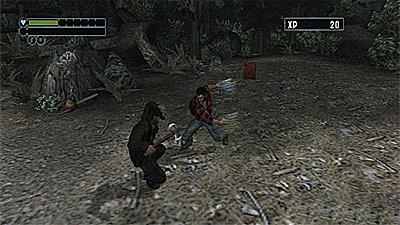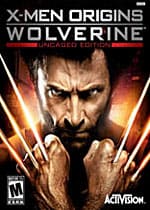Rated T For Toned Down
For me, there are few comic book characters more interesting than Wolverine. As such, I was elated that he received his very own summer blockbuster that attempted to explain an updated version of his origins to moviegoers. While there is sure to be a debate between fans as to how good the movie was based on how faithful it was to the comics, the video games that shipped alongside the film are much less likely to cause an argument. Basically, if you want to play a game that makes you feel like you are controlling Wolverine, then don’t bother playing the Wii or PS2 versions of X-Men Origins: Wolverine.

Some of this version’s biggest problems can be traced directly back to its ESRB rating. While the current-generation consoles got a mature-rated blood-soaked romp full of visceral attacks and limb-separating claw slices, the PS2 version takes a more family-friendly approach, coming in with a teen rating. Now instead of Wolverine’s indestructible, razor-sharp claws realistically mincing his foes into messy bits, they effectively just make his arms a little longer for a better range when punching and thrashing. Claw swipes don’t cause any discernable damage to foes, and the scratches they make on walls quickly disappear. However, you will still see an occasional, miniscule puff of blood after a random attack or briefly impale a downed foe, but these small payoffs are rare and none of them feel as satisfying as they should.
While some of the blame for this title being a letdown to Wolverine fans rests on the diminished levels of violence in this version, there are certainly a plethora of other things that keep it from being a great game. Firstly, as an action title that relies on combat for roughly ninety-five percent of your character’s interactions, fighting your way through the game couldn’t be less interesting. Some of this is clearly due to the lack of enemy variety; expect to fight the same few character models countless times, with all but the boss characters requiring anything more than basic attacks to dispatch. Making matters worse, the game is essentially just one closed arena after another full of enemies who will continue to spawn until you’ve killed enough to proceed to the next room.

The act of combat itself is not very interesting either, with the X and square buttons providing Wolverine with basic light and heavy attacks, respectively. While there may be actual combos in place that require specific ordered presses of these buttons, mashing them randomly is equally as effective and much easier to remember. If an enemy happens to be at a distance and firing incessant rounds your way, you can also try to make use of one of Wolverine’s lunge attacks. The key word here is “try,” as the game typically has troubles targeting any foes more than a few steps away from you. Also, since these lunges usually take longer to perform than just running up and slashing them, they end up being unusable in almost every situation. Players can also enter into a timed rage mode after charging an onscreen meter by killing enemies, which doesn’t do much aside from providing Wolverine with quicker health regeneration, stronger attacks, and a few special attack possibilities (that need to be unlocked) until the rage meter runs dry.
While endlessly taking down enemies gets old fast, each fallen adversary will grant you with some experience points. After gaining enough of this experience, the player can spend his hard-earned currency on upgrades that will make coasting through this title that much easier. This was actually one of the better aspects of Origins, allowing for the addition of more attack options, more health, quicker health regeneration, a longer rage mode, improved feral senses, etc.

Sadly, Wolverine’s feral senses happen to play a large role in the game. Switching these timed senses on and off will allow players to track some objectives using white smell trails that stand out against the red background, see invisible enemies in a similar fashion, and make important items that can be interacted with bright green. Some of this is neat, but since it is overused, it can also feel like an arbitrary way to lead you in the right direction as well as seem like a punishment at times when not being constantly used.
When not using feral senses you may get a small red flash letting you know to turn them on, which can be helpful but also causes you to stand still for a few seconds, leaving you open to attacks. Of course, with them turned on your feral senses meter will constantly drain, and you won’t be able to perform lunge attacks or interact with some objects, even ones that allow you to progress. These senses are also necessary for finding hidden items scattered throughout levels that will grant you large experience points boosts, allowing Wolverine to improve his abilities that much quicker.

Perhaps the only thing duller than this title’s gameplay is its presentation. Graphically, Origins is full of drab colors and textures, unremarkable/generic-looking environments, and tons of clipping. The game also makes use of a fixed camera which not only ensures that it frequently gives terrible angles, especially when trying to jump between platforms, but also results in objects and enemies often obscuring your view. This game’s sound is also less than flattering; with enemies repeating the same few lines of dialogue until you want to mute your television. The mute button is definitely your best option here, as even dialogue exchanged between the game’s more important characters is also abysmal and delivered with all of the intensity and emotion one would expect from a Christmas play being performed by second graders.
In the end, this version of X-Men Origins: Wolverine fails to live up to that of the current generation of consoles. While it is unreasonable to expect the same level of visual fidelity, the basics of the game could have remained the same and still provided a fun and worthwhile experience. Hell, the game even takes so much creative license with the story put forth in the movie that it is difficult to tell at times that these two products are even supposed to be based on similar events. If you are looking for a fun game that really makes you feel like you are controlling Wolverine, try Origins on the current generation of consoles. Just be sure you know what you’re getting yourself into with this version of the game, as this mature character and the teen ESRB rating don’t seem to mix well.
RATING OUT OF 5 RATING DESCRIPTION 2.3 Graphics
This game definitely doesn’t look great with its bland textures and frequent clipping issues. 2.7 Control
Everything works respectably, although jumping with circle button can be difficult to adjust to. 2.1 Music / Sound FX / Voice Acting
The music and sound effects are passable, but the repetitive and often awkward dialogue is mostly unbearable. 2.0 Play Value
Attacking wave after wave of similar-looking, respawning enemies in countless kill rooms with the occasional boss battle thrown in is enjoyable for about a half hour tops. Much past that and you’ll wonder if you also have Wolverine’s memory issues, since the feelings of déjà vu set in very quickly. 2.2 Overall Rating – Poor
Not an average. See Rating legend above for a final score breakdown.
Game Features:
